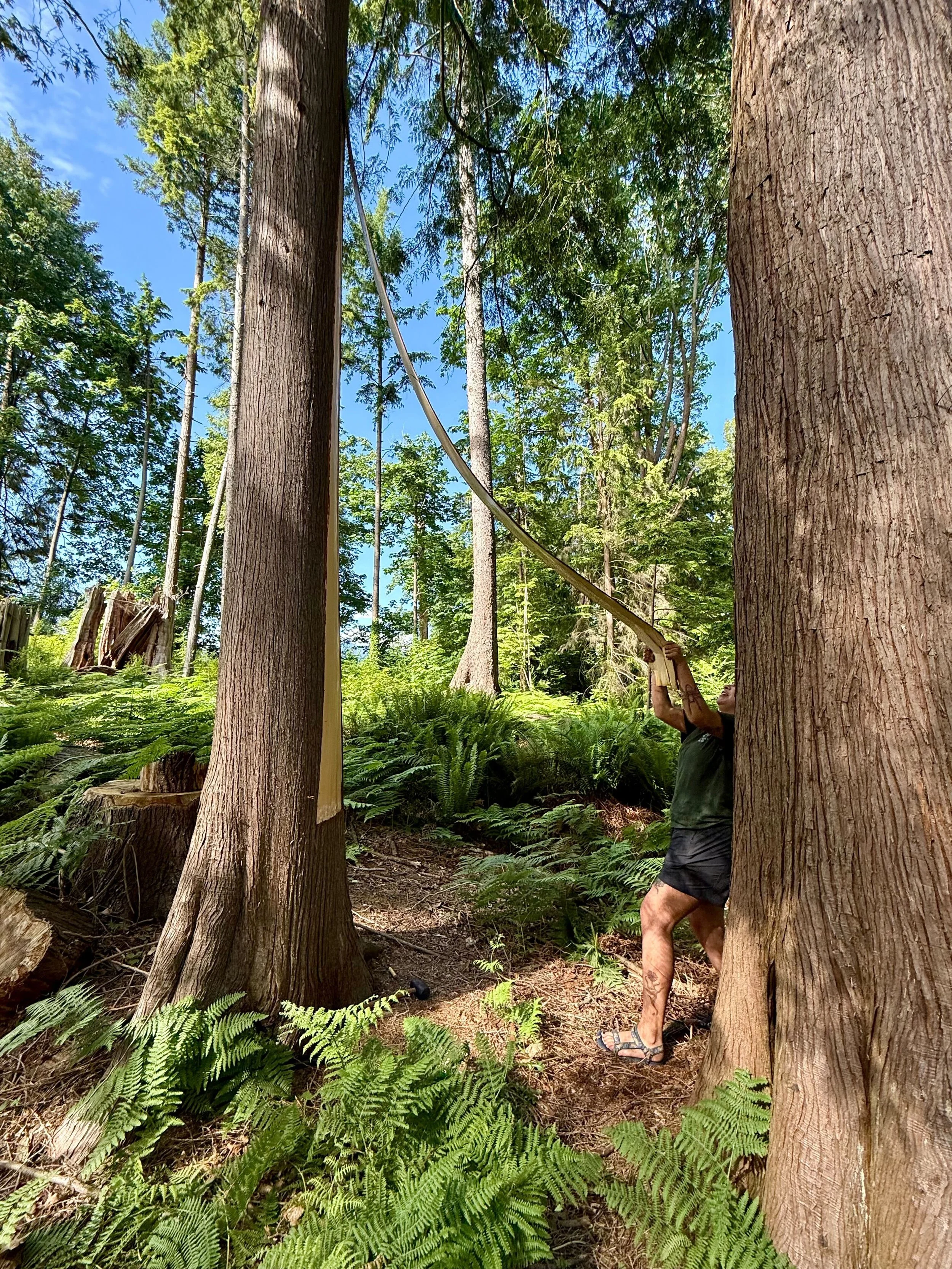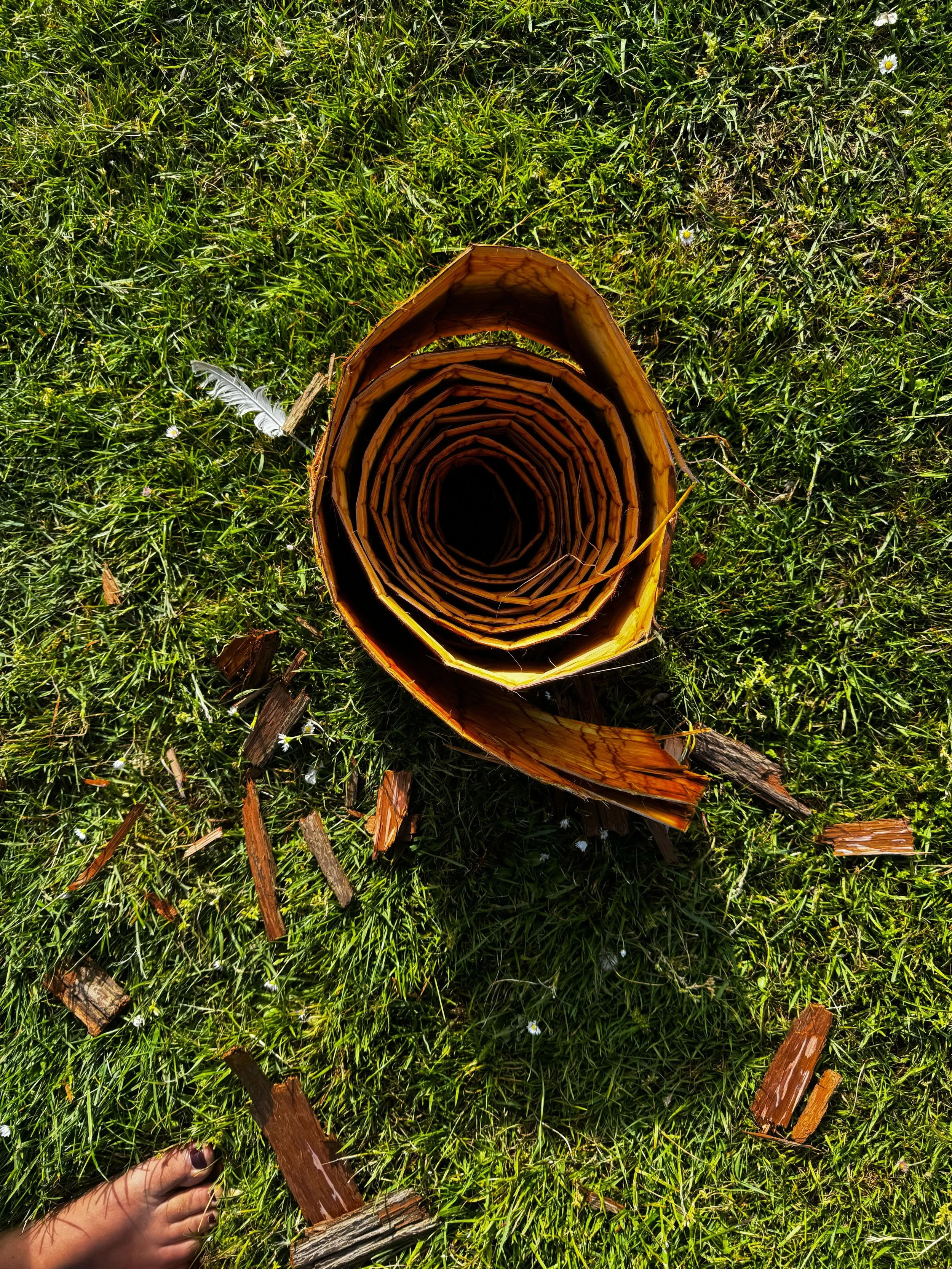Tsúyun súkw'em - Peeling cedar bark
Where to start when it comes to cedar?
I’ve known cedar my whole life. Or I should say, it knows me. I’ve been alive for twenty seven years–a blink of an eye compared to Cedar’s long life.
Cedar has been around since time immemorial, since time began. But there was a period when it disappeared, and it only returned after the last Ice Age. When the last Ice Age melted and the land dried out (roughly 10,000 years ago) my people returned to these lands.
Can you imagine, living on these lands with no Cedar? There was spruce, which was commonly used, but when Cedar returned around 5,000 years ago, our people started to thrive. Growing from Northern California to Alaska, this tree connects us all.
Wherever there is Cedar, there is Cedar People.
Thanking the Cedar Tree for it’s gift.
Why Cedar?
Our people reside in a coastal temperate rainforest. It’s wet, and rainy, and windy, and salty. All of the above. Cedar has seen my ancestors go by, taking care of them, watching over them.
Cedar watches us grow.
Cedar is:
Witness.
Spiritual protector.
Caretaker.
Ceremonial mask.
Our canoe.
Our home.
Umbrella.
Rain jacket.
Original waterproof hat and jacket of the west coast. Rot-resistant. Keeps us safe and dry.
I spent my summers up in Haida Gwaii with my dad’s family. If I ever said I was bored, my nonna would sit me outside with a big tub of cedar bark strips soaking in water and hand me a
knife. I got put to work. Hours, I would be out there, peeling the rougher outer bark away from the soft, spongy inner bark. It’s tedious work, perfect for keeping a little girl busy.
Sometimes my nonna would sit there with me and we would do it together. She never told me the reason, what we were doing it for. I didn’t ask. I just listened.
Years later, I graduated from high school, and in a naming ceremony I received my ancestral name. Kwii Gee Iiwans, “precious one”, my nonna’s mother’s ancestral was given to me. Before the ceremony, my nonna gifted me regalia, a beautiful purple blanket to wear in ceremony, and a beautifully woven cedar hat. Perhaps even made out of the same cedar I helped with. It was my nonna’s way of acknowledging me, that I sat with her, that I listened to her.
Cleared Ivy from the tree as thank you for sharing it’s bark with us.
It clicked for me then. Put in the work. Cedar takes time.
When you pull strips of bark, or pop out a plank for the longhouse, or make canoes, you have to let that fresh cedar sit for a long time, sometimes years, to let that strong cedar oil dissipate, otherwise you can get a rash. It’s not good for anyone to be touching it.
Cedar takes time.
The past few summers I’ve been harvesting cedar bark with friends and family. There’s a specific time of year when the inner sap is running that it’s possible to pull the bark off the tree,
otherwise it’s too stiff. Pulling it off the tree is only the beginning. Right there, you have to get to work, peeling the rough outer bark off the inner bark. This takes a while. Finally, you coil it up and keep it somewhere safe and dry.
Seraphine pulling the Cedar Bark off of the Tree.
The cedar has to rest for a long time after that to let the oil dissipate. Minimum one year. Sometimes it rests for years before it is soaked in water and ready to be cut into strips. Woven into all manner of things. Baskets, hats, capes, skirts, baby’s diapers, fishing nets, etc.
This past month, I took my coworkers cedar harvesting. We did it in Stanley Park, where we work, where we walk the land, where we educate about our land-based teachings. It seemed only fitting. We took our time finding the right cedar trees. Crawling up the tree was English Ivy, so we got to work, removing the invasive ivy from the area. A thank you, an act of reciprocity, before we harvested.
I pass by those CMT’s every time I work in the park now. Check on them. Say hello.
CMTs are: culturally modified trees. Test holes to check if the inside is rotted before cutting it down. Strips taken off. When there was old growth Cedar, entire canoes were popped out of the sides of their massive trunks and it would continue to thrive for many years after.
Roll of Cedar Bark.
It is living archaeology, living document. Every time we harvest cedar strips, we are documenting our lived experience on these lands.






